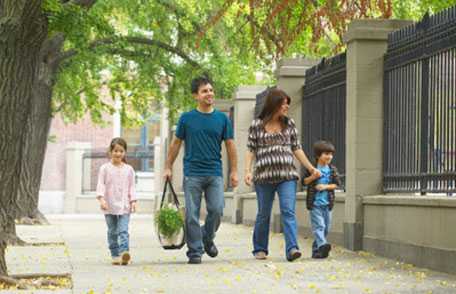Walk This Way! Taking Steps for Pedestrian Safety
 Take steps to be safe when walking on roadways. This includes exercising caution at intersections and crosswalks and increasing your visibility at night by wearing retro-reflective clothing and carrying flashlights.
Take steps to be safe when walking on roadways. This includes exercising caution at intersections and crosswalks and increasing your visibility at night by wearing retro-reflective clothing and carrying flashlights.
Walking is good for your health, and it’s good for the environment too. But before you head out on foot for a stroll, power walk, or errand, there are important safety tips to remember.
What’s the problem?
Pedestrians—people who travel by foot, wheelchair, stroller, or similar means—are among the most vulnerable users of the road.
In the next 24 hours, on average, 430 people will be treated in an emergency department for traffic-related pedestrian injuries.1 In the next 2 hours, on average, one pedestrian will die from injuries in a traffic crash.2
A total of 4, 735 pedestrians were killed in traffic deaths in 2013,2 and more than 156,000 were treated in emergency departments for nonfatal injuries. With numbers like these, it’s critical to understand the risks and learn how to stay safe.
Who’s at risk?
Pedestrians of all ages are at risk of injury or death from traffic crashes, but some people are at higher risk.
- Male pedestrians are more likely to die or be injured in a motor vehicle crash than females.2
- Teen and young adult (ages 15-29 years) pedestrians are more likely to be treated in emergency departments for crash-related injuries compared to any other age group.1
- The rate of pedestrian death generally increases with age.2
- In 2013, 34% of all pedestrians killed in traffic crashes had a blood alcohol concentration of greater than or equal to 0.08 grams per deciliter.2
As pedestrians, children are at even greater risk of injury or death from traffic crashes due to their small size, inability to judge distances and speeds, and lack of experience with traffic rules.
- One in five traffic deaths among children ages 14 and under are pedestrian deaths.2
 Take Steps for Safety
Take Steps for Safety
Whenever you’re walking, keep these tip2 in mind:
- Whenever possible, cross the street at a designated crosswalk or intersection.
- Increase your visibility at night by carrying a flashlight and wearing retro-reflective clothing.
- It’s safest to walk on a sidewalk, but if one is not available, walk on the shoulder and face traffic.
- Avoid distractions such as electronic devices that take your attention off the road.
Special Safety Tips for Children
It’s especially important to watch out for children’s safety when they’re walking near traffic.
The following resources offer tips on how to promote pedestrian safety for children—a critical step in preventing child pedestrian injuries:
Safe Routes to School (SRTS) Guide website
This Website gives information about how to start a SRTS program, an opportunity to make walking and bicycling to school safer for children and to increase the number of children who choose to walk and bicycle.
National Highway Traffic Safety Administration (NHTSA): Pedestrians
This website has materials about pedestrian safety that are geared toward children, as well as general pedestrian safety information.
References
- Centers for Disease Control and Prevention, National Center for Injury Prevention and Control. Web-based Injury Statistics Query and Reporting System (WISQARS) [online]. [cited 2016 Mar 9].
- Department of Transportation (US), National Highway Traffic Safety Administration (NHTSA). Traffic Safety Facts 201 3: Pedestrians [1.2 MB]. Washington (DC): NHTSA; 201 5 [cited 201 6 Mar 9].
More Information
More Information
CDC Resources
Other Resources
- World Health Organization: Pedestrian safety – a road safety manual for decision-makers and practitioners
- International Walk to School in the USA website
- National Highway Traffic Safety Administration – Prevent Pedestrian Crashes: Parents and Caregivers of Elementary School Children [PDF – 165KB]
- National Highway Traffic Safety Administration (NHTSA): Pedestrians
- Federal Highway Administration/ Safe Routes to School Program
- National Center for Safe Routes to School
- Pedestrian and Bicycle Information Center
- Page last reviewed: March 14, 2016
- Page last updated: March 14, 2016
- Content source:
- National Center for Injury Prevention and Control, Division of Violence Prevention
- Page maintained by: Office of the Associate Director for Communication, Digital Media Branch, Division of Public Affairs




 ShareCompartir
ShareCompartir